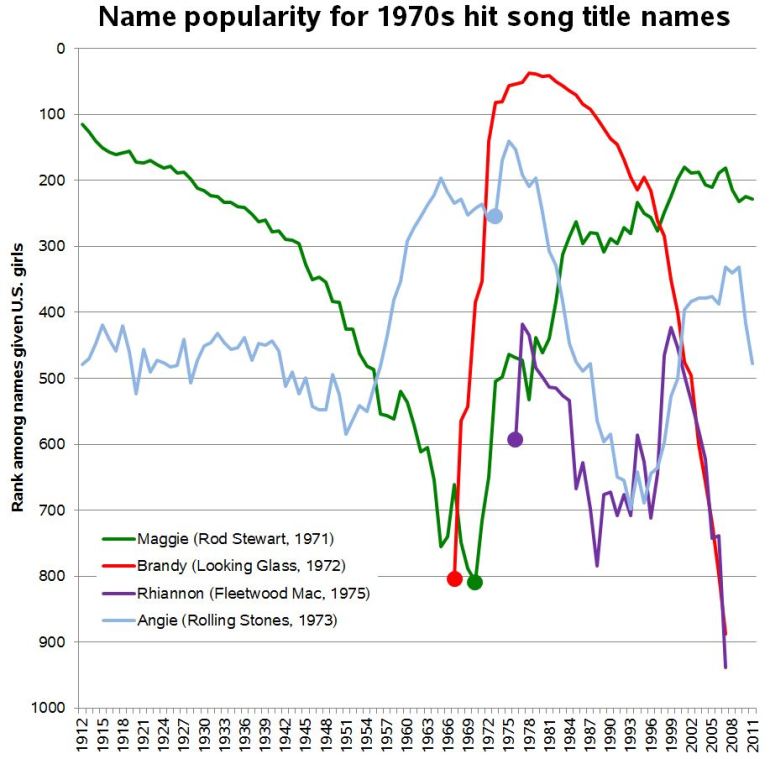In the comments of my Atlantic post about the name Mary, and in a number of personal emails, people have suggested pop culture triggers for changes in name direction – like the turnaround in Emma and its eventual peak at #1 in 2002. In that year, Emma jumped 9 places, from 13th to 4th among U.S. girls. There are other examples, but I prefer a few that date back to a golden era of pop songs with women’s names in the titles.
Some hits in the 1960s did not produce name bounces (Sharona, Sherry). But in the 1970s three #1 songs produced name bounces: Maggie (from “Maggie May,” by Rod Stewart in 1971), Brandy (Looking Glass, 1972), and Angie (Rolling Stones, 1973). I added a personal favorite, Rhiannon (Fleetwood Mac, 1975).

Each of these tells a good story.
- Rhiannon and Brandy both debuted in the top 1,000 names the year they made the charts, with Brandy making a credible run for the top before collapsing in the 1990s. Rhiannon hung on as a niche name until the 2000s.
- Maggie changed direction the year of the Rod Stewart hit, reversing a long slide.
- Angie, which gained popularity in the 1950s (Angie Dickinson?) seemed to get a boost from the Stones song, but it was not long lasting (it is a breakup song, after all). I don’t know why Angie came back in the 1990s (1994 movie with Geena Davis?).
My series of posts on names is here.
The names database is here.

Big Bertha, the WW I Howitzer…..couldn’t have helped….
LikeLike
In fall of 1971 I considered not going on to graduate school and becoming a billiards pro instead…
LikeLike
It seems like a good decision in retrospect. But who knows what would have happened?
LikeLike
How could you forget Michelle? Are you that young? She was climbing in the early 60s, but zoomed with Rubber Soul. Some people think that sudden rise of Madison came from “Splash” — not immediately, but when the girls who saw it as teens started having babies a few years later. But Harry Potter and Twilight have had no noticeable impact, at least not yet. Brandy seems part of a general trend favoring consumer goods perceived as upscale — Crystal, Tiffany, and perhaps others — but probably not among the parents who could more easily afford those items. It starts rising in the late 60s, declines in the late 80s.
LikeLike
Michelle must not have hit the US top 10? I thought I consulted a list of those…
Lieberson used a database of New York white girls’ names from 73-85, which included the education of the mother, and Crystal comes out as the name with the greatest education differentiation — most popular among high school dropouts and rare among college graduates. Emily is most highfalutin, with 5-times as many among college graduates than high school dropouts. One of his points is that names are free and not scarce, so this kind of division doesn’t last anymore.
Brandy may have rode that expensive trend after the song came out, but because she appeared on the list the year of the song I have to credit the song.
LikeLike
According to Wikipedia, the Beatles never released “Michelle” as a single in the US or UK.
LikeLike
It looks to me that Brandy was on a meteoric rise well before 1972.
Did you also check for Margaret and Angela?
LikeLike
I find it interesting that there was a modest post-1970 bump in the “Lola” (for girls, in case you were wondering). It then fell out of the top 1000 for 20 years, but came back in the early 2000s to hit the top 500 after 2005.
The first bump-up suggests an effect is less driven by the desirability or other attributes of the character in the song than it is by a simple, “oh, that’s a pretty name” effect. And, in this case, easy to spell. L-O-L-A lola….
LikeLike
I noticed that “Rhiannon” got another boost as big as the song later on in the ’90’s when the new wave of Gaelic names and derivatives of Gaelic names (Aidan, Kiera, etc.) became popular.
LikeLike